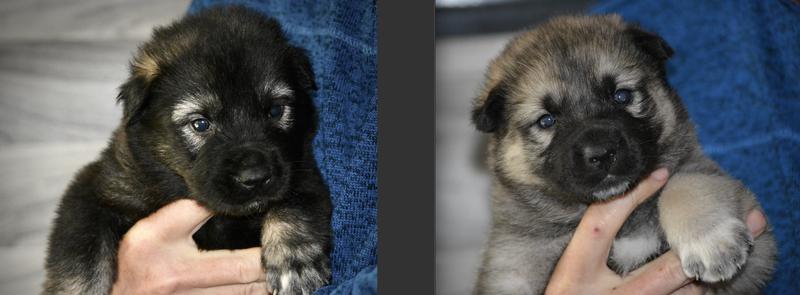Peer Inside a Strongbred Breeder's Mind
By Jennifer Stoeckl, MAT - Dire Wolf Project CEO, Oct. 28, 2021
I initially wanted to keep Zurg and Buttercup from the Toy Story Litter (Tudor/Razar), but when I received their DNA testing reports back, I changed my mind and chose the two gold wolf sable girls (Jesse and Trixie) instead. Why did I do that?
Here are some of my thoughts on the recent breeding decisions I made recently from the Toy Story Litter.
The reasons for the Toy Story Litter were many.
First, we need to continue to increase size in Razar's line and this was the litter to do it in. Both dogs carry only the known large genes and Tudor likely carries unknown giant genes. Since geneticists have yet to discover the genes for giant size in dogs (that I know of), we don't really have experience on if it is a recessive or dominant gene type. I have to be able to breed it and keep it in order to find out whether what exactly we are dealing with. My guess is that giant is recessive and if you see it you have it, but I do not know for certain. In any case, since all of the other genes that code for size will be large inherited, then we can choose the largest pup in the litter in an effort to capture the gene in this line and increase the likelihood of producing it in other litters coming from this line. Several dogs from this litter were quite large, which is why I was initially interested in Andy, but his temperament turned out to be a deal breaker for us, so I moved to his brother, Zurg, whose temperament was lovely with an overall large size.
(NOTE: We are working on obtaining 30-32 inches tall at the shoulders, or Dire Wolf sized, when standing on all fours. We are not talking Irish Wolfhound 40 inch height here.)
Next, Tudor carries the highly slanted eyes from his purebred white Alaskan Malamute grandmother, Elwin, and this trait is extremely difficult to capture in the breed. Domesticated dogs have been bred for so long to have dark brown rounded eyes, so moving to a high slant yellow-eyed wolfish look is very challenging. Tudor shows and carries this feature and I was commissioned by Lois to specifically work to capture this slanted eye in the puppies I kept from this match. It appears that the highly slanted eye might be dominant, so one copy of the trait shows on the dog, but that is still an unknown. Is the slanted eye feature held all on one gene? That, too, is not even close to being known. But, we have several dogs in our breed with this feature and it appears we are able to see it, select for it, and keep it in the breed if we are diligent about choosing puppies that show it. Luckily, we can tell pretty early one once the eyes open and focus at around 3-4 weeks old. Two puppies have this feature prominently in the Toy Story Litter, Zurg and Trixie. I like Zurg's temperament more than Trixie's, so I initially chose him over her.
One of the major deal breakers for me in choosing a dog to move forward in the breed is a long-haired, feathered dog (thin, wispy, human-like hair between the toes, behind the legs, and behind the ears) I have found that this feathered gene is not held in the wild wolf's DNA and that a long mane and thick, furred tail can only be truly seen on a dog that doesn't have feathering to produce a sort of false hair length that confuses and mimics, but isn't truely a wild trait. Wild wolves would never have long hair between their toes and in between the pads of their feet because it produces balls of hardened snow that would not allow them to hunt in the winter. Scientifically, we should eliminate this feature, but also for a less stressful existence in the winter for the dog. Since Razar has a copy of feathering in her DNA as does Tudor, I did not want to increase its occurrence in my lines moving foward. Unfortunately, both Zurg and Buttercup had a double copy of the feathering gene and Trixie and Jesse did not.
Another consideration was the recessively held "no mask" or self mask gene (E). I knew that every puppy was going to have a black mask, but in order to move forward with my breeding plans, I needed to keep a dog with the recessive "no mask" gene (E). Buttercup held the "white switch" gene (e), which we do not want to increase in the breed. Not only would I not have an opportunity to keep the no mask in this line, but I would also increase the likelihood of producing recessive white pups, which we do not wish to do. (It is not a wild wolf trait)
Another important feature I am actively working on is decreasing the amount of white spotting in my dogs. There is a three-fold reason for this. First of all, excessive white spotting is linked to some health issues, including skin issues and possible deafness. Secondly, wild wolves do not show white spotting. It is a feature of domestication only. Thirdly, I cannot hope to determine whether I can produce a no maked dog (E/E) that is born with a black mask unless I eliminate the white spotting variable. It was imperative that I choose a puppy that had both copies of the no spotting gene (S/S) or at least one copy of it. (S/sp) Buttercup ended up having two copies of white spotting (sp/sp) which would have only increased my odds of producing dogs with white spotting. Her temperament was great, but so were Jesse and Trixie's who had no white spotting in their DNA (S/S).
Temperament being great in all the dogs I was considering, I could focus on the cosmetic features that I needed to move forward with my lines. I know that they have higher coefficient of inbreeding (COI) than we want. I also know that they are gold wolf sables and not silvers, but they carry silver in the recessive and will throw it in their puppies, so we will simply have to breed them correctly when the time comes.

So, in summary, Zurg did have highly slanted eyes, he was large, has a superior temperament, and is a silver wolf sable coat. However, he also carried for feathered coat, white spotting, and recessive black coloring. Therefore, I chose to pass him up for Trixie. Trixie also has highly slanted eyes, large size, and superior temperament. However, she also has the added benefit of carrying for no white spotting, no mask, and no feathered coat type.
Buttercup is a large silver wolf sable female with a broad head and a great temperament, but she carries two copies of white spotting, and the gene that eliminates black pigmentation in the coat (e). Despite the gold wolf sable coat coloring, Jesse is large, carries for no mask and no white spotting.
Ultimately, it was a difficult decision. I think it best to have as many traits that I need as I possibly can. Because the temperaments in these four were comparable, I was able to focus more on the superficial looks within this line. I hope I did not lose giant size in the process. I kept two girls in hopes that at least one or both of them will show a larger size like their father, Tudor.
We would like to send you a free gift for spending some time with us at the Dire Wolf Project.
10 Ways to Alter Your Dog's Diet for Immediate Health Results
Jennifer Stoeckl is the co-founder of the Dire Wolf Project, founder of the DireWolf Guardians American Dirus Dog Training Program, and owner/operator of DireWolf Dogs of Vallecito. She lives in the beautiful inland northwest among the Ponderosa pine forests with her pack of American Dirus dogs.